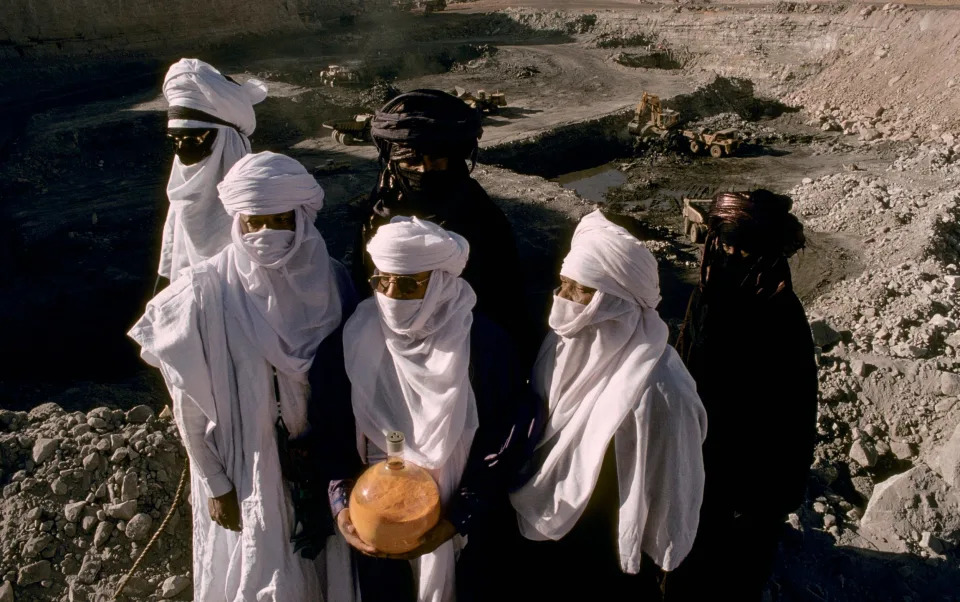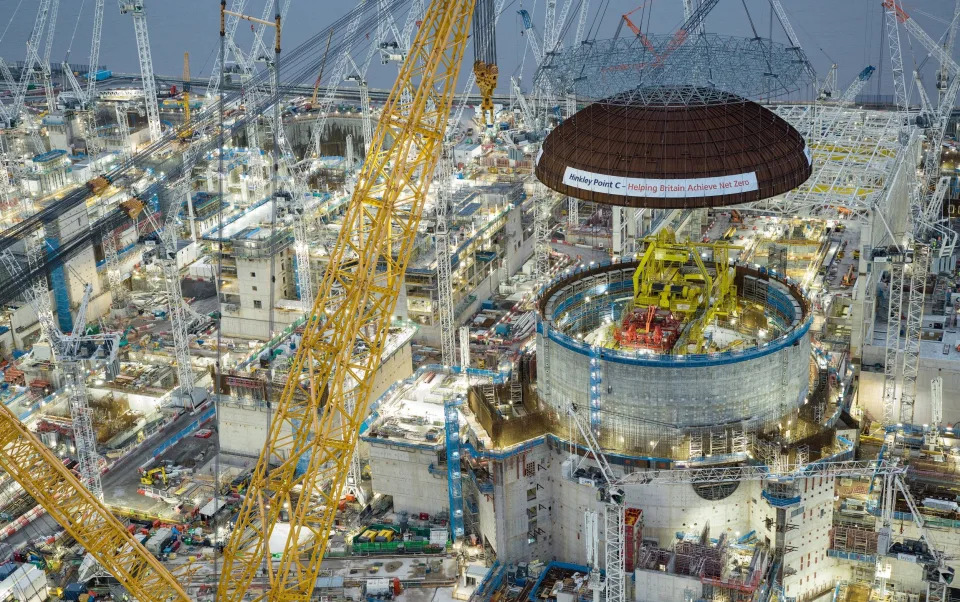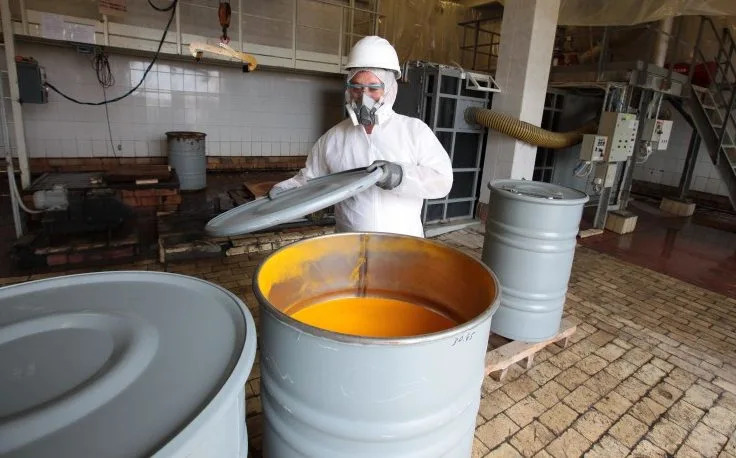Matt Oliver
23 December 2023·

Since the Ukraine war erupted, Kazatomprom has sought to reduce its reliance on Moscow for getting uranium to the West, sending more via what it calls the ‘trans-Caspian route’ - Olivier Martel Savoie/The Image Bank Unreleased
Already stretched uranium supplies are set to come under further pressure as dozens of new nuclear power plants come online globally
Britain’s long-promised nuclear renaissance edged forward this month, as a crane swung a gigantic domed roof into place on a reactor building at Hinkley Point C in Somerset.
Emblazoned across it, a large banner declares: “Helping Britain achieve net zero”.
The site’s two reactors, which are expected to come online in 2027, are among 61 being built around the world, as more countries turn to nuclear to help cut their carbon emissions.
Yet with hundreds more planned, experts are now asking where all the uranium to fuel them will come from. There is a worrying lack of answers.
The uncertainty has driven the price of the radioactive metal to heights not seen in more than a decade.

The world’s largest crane has been used to place a roof wider than the dome of St Paul’s Cathedral on top of the Hinkley Point C - Handout/AFP
On the same day Hinkley’s reactor building was crowned, the price of uranium jumped to $85.75 a pound on the spot market.
That is the highest level since January 2007 and compares to just $24 per pound at the start of 2020.
This month, Morgan Stanley analysts predicted it will rise to $95 in the first half of next year, while others believe it could easily go much higher.
The driving force is the fear of a decade-long supply crunch, as demand for uranium ramps up but miners struggle to get the metal out of the ground quickly enough.
Demand is forecast to reach 180 million pounds this year alone, compared to just 130 million pounds of expected production, according to London research company Ocean Wall, a uranium specialist.
Normally in a situation like this, high commodity prices would prompt miners to rapidly invest in new projects to boost overall supplies. But uranium is a different story, says Ben Finegold, an analyst at Ocean Wall.
Reopening mothballed mines will barely move the needle on supply globally. Meanwhile, it typically takes more than a decade to open new ones.
“The supply response is going to be so slow,” Finegold says.
“Frankly, if the uranium price were to jump to $500 a pound tomorrow, it would do very little for meaningful volumes of supply in the short to medium term.”
Mining uranium is more complicated than mining other precious metals, partly due to restrictions on how it is transported and stored.
In the past decade, production of raw uranium concentrate (known as yellowcake) has plunged from a peak of 69,966 tonnes in 2013 to 58,201 last year. According to the WNA, that is more than 10,000 tonnes below current reactor requirements – let alone planned ones.
The malaise set in after the 2011 Fukushima nuclear disaster in Japan, which prompted some countries such as Japan and Germany to shut down reactors.
This caused utility firms to flood the market with excess fuel, sending the price of uranium crashing to levels that made mining unprofitable, particularly for western operators.
Worse still, when the Covid pandemic struck in 2020 some miners were forced to halt activity altogether.
It has created a supply deficit of the kind unseen for many years, forcing European and American utilities to draw down on inventories built up over years.
Now, those stockpiles are dwindling.
“Inventory is a finite resource, and at some point they run out,” says Malcolm Critchley, president of US uranium processor ConverDyn. “And then you’re faced with a sort of fundamental problem in the market, where supply is lagging behind demand.”
Uranium supplies will be stretched for years to come. The simplest explanation for the supply crunch is that countries are building a huge number of reactors, in many cases to cut their carbon emissions and achieve 2050 “net zero” targets.
Worldwide, in addition to the 61 reactors being built, another 112 are in the planning process (including two at Sizewell C in Suffolk). A further 318 are proposed in some form, the WNA says.
This construction boom is largely driven by enormous programmes in China and India, as well as Middle Eastern countries including Turkey and Egypt.
The scale of China’s programme alone is staggering. There, the number of reactors in operation has risen from 17 to 55 since Fukushima – a period during which the UK started but failed to finish a single one.
Meanwhile, another 25 are under construction and plans are being drawn up for nearly 200 more.
That has prompted Beijing to build a massive stockpile of uranium as well.

In the past decade, production of raw uranium concentrate (known as yellowcake) has plunged from a peak of 69,966 tonnes in 2013 to 58,201 last year - Handout Publicity Material
Over the next 15 years, Ocean Wall predicts China could hoover up one billion pounds (about 454,000 tonnes) of the metal, equivalent to roughly half of all global supplies if production remained static.
Other factors are pushing up prices as well. Many older reactors are now expected to run for longer, after countries including the UK, US and France opted to extend their lifetimes, while some that were idled in Japan are being brought back online.
Uranium mining is dominated by a small cabal of countries and businesses, with parts of the supply chain heavily concentrated into a few hands.
Kazakhstan’s state miner Kazatomprom is by far the largest producer, with 23pc market share, according to the World Nuclear Association (WNA).
Other top miners include Canada’s Cameco (12pc), France’s Orano (11pc), China General Nuclear (10pc) and Russian state owned Uranium One (9pc).
Producers are struggling to respond quickly to increased demand, in part because of how long they were stuck in low gear. Cameco in September slashed the 2023 production forecast for its Cigar Lake mine from 18 million pounds to 16.3 million pounds, citing equipment problems.
Adding to supply pressure is the fact that US lawmakers are pushing for a ban on imports of Russian uranium, with a bill passed in the House of Representatives earlier this month waiting to clear the Senate.
That will make life harder for American utilities, which currently source about 12pc of their supplies from Russia and about 25pc from Kazakhstan, which has historically shipped uranium out of St Petersburg.
Since the Ukraine war erupted, Kazatomprom has sought to reduce its reliance on Moscow for getting uranium to the West, sending more via what it calls the “trans-Caspian route” – or the “new nuclear Silk Road” to some analysts.
Getting uranium to the US via St Petersburg reliably takes around 32 days. However, sending it west along this new Silk Road takes 43 days and is riskier and more expensive.
Yellowcake has to be sent first by rail to the Kazakh port of Aktau, then is shipped across the Caspian sea to the port of Baku in Azerbaijan, which is in conflict with neighbouring Armenia, before travelling by rail again to the port of Poti in Georgia.
It is then sent by ship through the contested Black Sea – hugging the coast of Turkey all the way – before passing through the Bosphorus strait and into the Mediterranean.
Kazatomprom claims it is now sending as much as 70pc of western supplies this way. But the route’s riskier nature has led to fears that the company may instead end up dealing more with China, which has built an enormous warehouse near its border with Kazakhstan to store trainloads of uranium that are constantly arriving.
Some western commentators have pointed to Australia as a solution to the crunch, where the world’s biggest reserves of uranium are buried. However, Ocean Wall’s Finegold argues there are not enough projects underway yet to even begin to address the global shortfall.
He believes the only answer is for western miners to open a generation of new pits, but this will take time.
“There has to be a higher incentive for Western production,” he explains, “whether that’s higher prices or a slightly more relaxed regulatory framework.”
Back in Somerset, operator EDF says it has already safely secured the uranium needed to fuel Hinkley Point C from countries including Kazakhstan and Canada.
That is reassuring for now. But if the UK wants to build yet more nuclear reactors, we had better start thinking about how to fuel them.
No comments:
Post a Comment